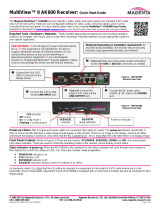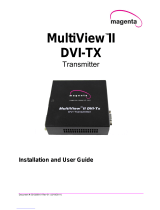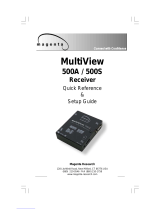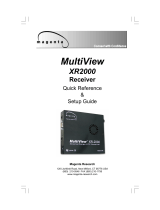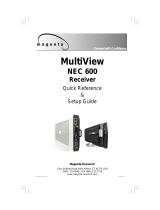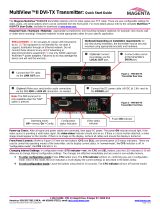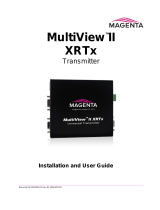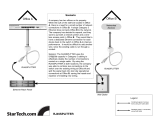Page is loading ...

Document # 5310188-02 Rev-01 (3/22/2012)
MultiView II
T4
Transmitter
Installation and User Guide
TM

MultiView™ II T4 Installation and User Guide ii
© 1998-2012 by Magenta Research, Ltd. All rights reserved.
Magenta Research, Ltd.
128 Litchfield Road
New Milford, CT 06776 USA
This document and the Magenta Research Ltd. products to which it relates, and the copyright in each, is the property of Magenta Research Ltd. Neither
the document nor the products may be reproduced by any means, in whole or in part, without the prior written permission of Magenta Research. Magenta
Research makes no warranty or representation, either express or implied, with respect to this software or documentation, including their quality,
performance, merchantability, or fitness for a particular purpose. As a result, this software or documentation is licensed "as is" and you, the licensee, are
assuming the entire risk as to their quality and performance.
In no event will Magenta Research be liable for direct, indirect, special, incidental, or consequential damages arising out of the use of or inability to use
the hardware, software or documentation.
Magenta Research and the Magenta Research logo are trademarks of Magenta Research, Ltd.
All other brands, product names, and trademarks are the property of their respective owners.
Magenta Research reserves the right to change product functionality and/or specifications at any time without prior notification.

Precautions
MultiView™ II T4 Installation and User Guide iii
Precautions
Safety Instructions
● English
This symbol calls attention to important information.
This symbol is intended to alert the user of important maintenance (servicing) and operating information.
This symbol is intended to alert the user to the presence of un-insulated dangerous voltages or other
conditions in or around the product enclosure which may present a risk of electric shock, damage to
equipment or facilities.
Caution:
Read instructions: Read and understand all operating, installation and safety instructions before using this
equipment.
Avoid Attachments: Do not use accessories, attachments, tools or materials that are not recommended by the
equipment manufacturer. Doing so may compromise operating performance, create an unsafe condition,
damage equipment, or violate the terms of usage or warranty.
Follow Warnings: Always follow all instructions and warnings marked on the equipment or as detailed in the
related user documentations.

Contact Information
MultiView™ II T4 Installation and User Guide iv
Contact Information
For sales or technical support, contact your nearest Magenta Research sales office.
Region
Contact details
North, Central and South
Americas:
Magenta Research, Ltd.
Corporate Headquarters
128 Litchfield Road
New Milford, CT 06776 USA
Main: 800-805-0944 (USA only) or +1 860-210-0546
Fax: 1-860-210-1758
Web: www.magenta-research.com
Sales: sales@magenta-research.com
Support: techsupport@magenta-research.com
Sales/Support phone hours: 8:
0
0
-
17:
0
0 (EST: GMT
-
0500)
Asia:
Magenta Research Asia Limited
Unit 1 21/F Cheung Tat Centre
Chai Wan, Hong Kong
Main: 852.3105.1493
Fax: 852.3105.1491
Contact: awaung@magentaresearch-asia.com
Sales: awaung@magentaresearch-asia.com
Pan European Office:
Magenta Research, LTD
Main: +44 7708-850582
Contact: rmuddiman@magenta-research.com
Sales: sales@magenta-research.com
For all RMA return shipments, use
this address unless you are
advised otherwise:
Magenta Research, Ltd.
RMA Department
128 Litchfield Road
New Milford, CT 06776 USA
Prior to returning any products, please contact Magenta’s support line
to obtain an RMA number. This RMA number is essential for tracking
your returns and for ensuring they are processed in a timely manner.
Support Phone: 800-805-0944 (USA only) or +1 860-210-0546
Support e-mail: techsuppor[email protected]
Support phone hours: 8:00-17:00 (EST: GMT-0500)

Table of Contents
MultiView™ II T4 Installation and User Guide v
Table of Contents
Page
Chapter 1
About this Manual ...................................................................................................................... 1
Chapter 2
Product Overview ....................................................................................................................... 2
2.1
Front Panel interfaces ..................................................................................................... 2
2.2
Rear Panel interfaces ..................................................................................................... 2
Chapter 3
Specifications ............................................................................................................................. 3
3.1
General Specifications .................................................................................................... 3
3.2
DDC/EDID Support ......................................................................................................... 4
3.3
Auxiliary Signal Support .................................................................................................. 5
3.4
CAT5 Cable Compatibility ............................................................................................... 5
Chapter 4
Installation .................................................................................................................................. 6
4.1
Prerequisites ................................................................................................................... 6
4.2
Installation Procedure ..................................................................................................... 7
4.3
Configuration ................................................................................................................... 9
4.3.1
DDC Mode Selection ...................................................................................... 9
4.3.2
General Configuration Settings ...................................................................... 9
4.3.3
Setting Factory Defaults ................................................................................. 9
4.3.4
Config Mode-1: Sync-mode Options ............................................................ 10
4.3.5
Config Mode-1: 4
th
Pair Settings ................................................................... 10
4.3.6
Config Mode-2: Video Coupling .................................................................... 11
4.3.7
Config Mode-2: Video Termination ............................................................... 11
Chapter 5
Troubleshooting ....................................................................................................................... 12
Appendix A
Connector Pinouts ................................................................................................................... 14
Appendix B
Mounting Kits ........................................................................................................................... 18
Appendix C
System Design Drawings ......................................................................................................... 19
Appendix D
Regulatory Compliance Information ......................................................................................... 20
Appendix E
Spares & Options ..................................................................................................................... 21
INDEX 22

About this Manual
MultiView™ II T4 Installation and User Guide 1
Chapter 1 About this Manual
This manual contains information about the Magenta MultiView™ II T4 transmitter (hereafter referred to simply
as “T4”). This includes:
• Product overview (Chapter 2).
• Product specifications (Chapter 3).
• Installation and configuration instructions (Chapter 4)
• Troubleshooting (Chapter 5).
• Additional information (Appendices).
The Magenta MultiView™ II family of products introduces greater compatibility for handling HD video standards,
as well as making nearly all user-configurable options “jumperless” via a digital front-panel user-interface.
The T4 transmitter is available in two factory-configured versions:
• MVII-T4-A:
o Supports L+R summed audio.
• MVII-T4-S:
o Supports simplex serial.
Note that these two models are fundamentally identical, differing only in a user-configurable setting which is
easily changed in the field.
The T4 transmitter is also capable of supporting S/PDIF digital audio on the 4
th
-pair. This is also a user-
configurable option that is easily selected from the front panel.
This equipment is not intended for, nor does it support, distribution through an Ethernet
network. Do not connect these devices to any sort of networking or telecommunications
equipment!
Use only Magenta Research LTD approved MultiView™ II power adapters. Failure to do so may
damage this device and will void the warranty.

Product Overview
MultiView™ II T4 Installation and User Guide 2
Chapter 2 Product Overview
The Magenta MultiView™ II T4 transmitter extends an analog video signal over standard CAT5 cable (also
CAT5e and CAT6). It accepts analog video (VGA, RGB and other analog formats), audio (analog or S/PDIF) or
serial (RS-232 simplex) signals. These are converted to MultiView™-compatible signals, provided over 4 UTP
output ports.
The T4 also features an enhanced front-panel interface for user-configuration and DDC/EDID management.
There are no internal configuration settings or jumpers. Everything can be set from the front-panel buttons. The
T4 transmitter is compatible with the entire Magenta MultiView™ family of products.
2.1 Front Panel interfaces
The front panel of the T4 transmitter has the following ports, controls, and indicators:
There are two buttons (COPY/CFG and DDC MODE/SEL) and several green LED status indicators (numbered
1-8). These are used to display and control the operating modes of the transmitter, with the LEDs having multiple
functions.
In “normal mode”, the CFG indicator is off. In “configuration mode”, the CFG indicator is on or flashing.
2.2 Rear Panel interfaces
The rear panel of the T4 transmitter has the following ports:
Auxiliary signal
local output port
Video-status
& DDC-copy
indicator
Operating mode:
Off = Normal
On/Flashing = Config
COPY/CFG
button
DDC
MODE/SEL
button
Local video output port
(to display – optional)
DC Power
input
Video input port
(from source)
UTP (link) output
ports (x4)
Power-on
indicator
Auxiliary signal
input port

Specifications
MultiView™ II T4 Installation and User Guide 3
Chapter 3 Specifications
3.1 General Specifications
Item
Description
Cable Required Category 5, 5e, 6 cable. Shielded or unshielded twisted pair. Low-skew.
Compliance CE, FCC Class A, IC Class / Class A, UL listed I.T.E Device, RoHS.
Video Support RGBHV, RGB, Composite, S-Video, and Component Video modes.
Resolution &
Refresh Rate
To 1920x1200 @ 70Hz.
Maximum Distance To 2000 ft, receiver dependent.
Interface Signal
Details
Video-input:
Standard VGA (HD-15) video connection. The R/G/B signals have a 75-ohm input
impedance. DDC is supported.
Auxiliary Signals (only one type at a time):
L+R summed audio input: 47K ohms input impedance. A source device with 600
ohms maximum output impedance is recommended (analog audio input mode).
Simplex RS-232 input: 4.75K ohms input impedance (simplex RS-232 mode).
S/PDIF input:
75 ohms input impedance (S/PDIF input mode).
Local-output port
drive impedance
Video-output:
Standard VGA (HD-15) video connection. Will drive a 75-ohm impedance on the R/G/B
signals. DDC is supported.
Auxiliary Signals (only one type at a time):
L+R summed audio output: Will drive a 600 ohm (or greater) load impedance (analog
audio output mode).
Simplex RS-232 output: Will drive a 600 ohm (or greater) load impedance (simplex
RS-232 mode).
S/PDIF output:
Will drive a 75 ohm (typical for S/PDIF) load (S/PDIF output mode).
Audio
Characteristics
(A) version: Left+Right summed audio.
Serial
Characteristics
(S) version: Simplex-serial, any speed up to 115.2K baud. Transparent to format and
protocol.
Connectors
Standard connectors:
(2) HD15 (VGA) female: Video in/out.
(4) RJ-45: MultiView CAT5 link output.
(2) 4 position phoenix: Auxiliary signal input/output.
(1) Coaxial (5.5mm OD, 2.5mm ID, 11mm L) jack: DC power input.
Temperature
Tolerance
Operating: 32 to 104°F (0 to 40°C)
Storage:
-
4 to +140°F (
-
20 to +60°C)
Humidity
Tolerance
Up to 80% noncondensing
Enclosure Steel, black powder-coat finish.
Power
Input voltage: +5 VDC @ 1 Amps max.
Consumption: 5 watts maximum
Size
1.2"H x 5.6”W x 4.5”D (3.1 x 14.2 x 11.4 cm)
Weight 1.1 lb. (0.5 kg)
MTBF
100,000 hours

Specifications
MultiView™ II T4 Installation and User Guide 4
3.2 DDC/EDID Support
For best compatibility with source devices (ex: a PC), an extension device (T4 in this case) should provide an
appropriate DDC/EDID profile with the proper resolution and timing information. This helps ensure best
compatibility with display devices connected at the remote end.
The T4 supports a simple yet very flexible DDC/EDID management scheme:
• The built-in factory-default DDC/EDID profile supports a number of standard resolutions and timing
information that is widely compatible with many displays.
• A specific DDC/EDID profile can be copied from a particular display and stored inside the T4’s internal
non-volatile memory. This method enables the best possible compatibility with a specific display that
would otherwise not work properly if simply using the factory-default DDC/EDID profile.
• Finally, the T4 supports a “pass-through” mode, where the DDC/EDID profile of a locally attached
display is passed directly to the video source. This can be very helpful in diagnosing certain resolution or
timing related display issues, but generally is not used on a permanent basis (though it is safe to do so).
DDC
/
EDID Parameter
:
Presented to the source when using the
T4
transmitter
:
Manufacturer name string MRI
Monitor name
string
Magic Display
Established timings
640x480@60Hz 800x600@60Hz 1024x768@60Hz
1280x1024@60Hz 1360x768@60Hz 1600x1200@60Hz
1920x1080@60Hz 1920x1200@60Hz
Detailed timings
1920x1080@60Hz
1
280
x
720
@60Hz
720x480@60Hz
CEA video formats
720x480p@(59.94,60Hz)@4:3 720x576p@50Hz@4:3
1280x720p@50Hz@16:9 1280x720p@(59.94,60Hz)@16:9
1920x1080p@50Hz@16:9 1920x1080p@(59.94,60Hz)@16:9
Specific timings
1280x720@60Hz

Specifications
MultiView™ II T4 Installation and User Guide 5
3.3 Auxiliary Signal Support
The MVII-T4 design supports three types of auxiliary signals. Two are available pre-configured from the factory.
The third option is easily user-selectable from the front-panel buttons. Note that only one type of signal is
supported at a time:
• Factory option, MVII-T4-A:
o Supports L+R summed audio.
• Factory option, MVII-T4-S:
o Provides simplex (TX-only) serial data, even with daisy-chained receivers.
o Data is transmitted to all attached receivers. No data can ever be received.
o Receivers are not individually addressable.
o RS-232 interface supports a 2-wire interface: TX/GND.
o Baud rates up to 115.2K are supported. No settings required.
o Transparent to format and protocol.
• User-selectable, MVII-T4-S/PDIF:
o Supports digital S/PDIF audio.
Note that for each T4 configuration above, the accompanying receiver device (MV500, AK600, AK1200, XR2000,
etc.) must be similarly configured.
For more specific information on MultiView™ receivers, please refer to the user-guide provided with your desired
receiver.
3.4 CAT5 Cable Compatibility
The MultiView™ family of products enable the highest quality video extension over common Category 5 (CAT5)
cable. In some applications, system design or environmental factors can require the use of CAT5e and CAT6
cabling (with and without optional shielding). Each installation may have special requirements, and it is up to the
system designer to determine the most appropriate type of cable to deploy with MultiView™ products. In any
case, if there is any doubt with regards to a specific type of cable it is strongly advised that actual testing be
performed using an appropriate length of the desired cable – BEFORE that cable is specified and installed.
The T4 transmitter provides 4 UTP output ports. Each port in turn supports a daisy-chain CAT5 connection to
multiple receivers. This allows one video source to be sent to many displays at the same time – with the absolute
minimum amount of signal degradation possible.
Magenta Research products are compatible with standard CAT5/5e/6 data cabling as well as specialized “low
skew” cabling manufactured primarily for video applications. Note that some “low skew” cabling is specific to a
particular equipment vendor or application and may not compatible with MultiView™ products. Please ensure
any “low-skew” CAT5 cable is non-proprietary prior to purchase/installation.
Standard CAT6 cable, due to the manufacture method, can exhibit much greater skew than standard CAT5/5e
and may require skew compensation beyond what the standard product offers. Please contact Magenta
Research for assistance.
The CAT5/5e/6 cable should be suitably rated Listed cable (DUZX) communication cables, TYPE CMP, CMR,
CMG or CM as designated in the NEC. Cables are to be installed in accordance with the NEC and local building
and electrical codes. This is the responsibility of the end user/installer of this product.

Installation
MultiView™ II T4 Installation and User Guide 6
Chapter 4 Installation
CAT5/5e/6 cabling for the Magenta MultiView™ II Series must be pinned to the TIA-EIA T568B wiring
specification.
Figure 1 T568B CAT5 Specification
We also highly recommend that all CAT5 cables be pre-terminated and tested. Cables terminated on-site or in
an existing infrastructure should be tested before use to ensure compliance with the TIA-EIA T568B
specification. Using incorrectly terminated CAT5 cables can damage the Magenta MultiView™ devices.
This equipment is not intended for, nor does it support, distribution through an Ethernet network. Do
not connect these devices to any sort of networking or telecommunications equipment!
Do not connect DC power until instructed to do so.
4.1 Prerequisites
Depending on the specific installation requirements, some common tools (screwdrivers, nut-drivers) and related
hardware (mounting screws) may be required. These are not provided with Magenta products.
The following items may be necessary, which are available from Magenta Research:
• Appropriate audio cabling.
• Appropriate video cables and adapters (if needed).
• Auxiliary signal cables.
Of course, you will need appropriate CAT5 cable, as previously described, to connect the T4 to MultiView™
receivers and other MultiView™ devices.

Installation
MultiView™ II T4 Installation and User Guide 7
4.2 Installation Procedure
All units must be the same type for all supported features to function correctly. For
example, a “T4-S” transmitter must be connected to a MultiView™ “-S” type receiver for the
serial interface to function properly. You cannot mix one version of a T4 with a different
version of a MultiView™ receiver. Video modes may function normally, but 4th pair options
will not.
Ensure all connectors are clean and free of contaminants prior to making the connections.
Appropriate connector locking hardware (screws/latches) should be used to prevent cables
from disconnecting or causing intermittent operation.
At the T4 transmitter end:
1. Connect the source video to the Magenta MultiView™ II Series transmitter video input
port, which is a standard HD15-female (VGA) connector labeled SOURCE IN.
2. If desired, attach a local monitor to the VGA connector labeled LOCAL OUT (optional).
3. Connect up to 4 CAT5 cables to the transmitter LINK OUT ports. All link-out ports have
the same signals – it does not matter what order they are used in.
4. Make your audio or serial connections via the phoenix AUX IN and AUX OUT
connectors (optional).
5. Apply power to the T4 transmitter.
a. The power-on LED should turn on. All other LEDs should execute a power-up
test sequence.
b. If the video source is providing a valid RGBHV video signal, the Video Status
indicator should turn on. Note: It will remain off for YUV, S-Video, and any
other analog formats that do not use separate H/V sync signals.
c. If there’s a local monitor attached, a video image should appear on the
monitor’s screen.
6. Remember to make any required T4 configuration changes via the LED/button user-interface.
Connect CAT5 cable(s)
to the LINK OUT ports.
(Optional) Connect a
local display to the
LOCAL OUT
port.
Connect a video
source to the
SOURCE IN port.
Connect the DC power
cable (+5VDC) to the
power
port.
Power-on
indicator
T4 Transmitter Rear View
T4 Transmitter Front View
Video status and DDC-copy indicator
(Optional) Make your serial or audio
connections via the AUX connectors, as
needed
.

Installation
MultiView™ II T4 Installation and User Guide 8
At the receiver end (these steps are generic - refer to the appropriate receiver manual):
1. Connect the VIDEO OUTPUT connector to the display, and attach any audio (AUX I/O)
and/or serial connections depending on the model of MultiView™ receiver and option
module installed.
2. Connect the CAT5 cable to the LINK IN connector. If you are daisy-chaining multiple
receivers, also connect the downstream CAT5 cable to the LINK OUT port on the
receiver.
3. Apply power to the receiver.
a. The power-on LED should turn on.
b. The status-LED should turn on (Green).
4. Make any required configuration changes via the LED/button user-interface, if the
receiver is equipped with this capability.
5. Adjust the receiver’s EQ and/or SKEW (optional) settings. If this adjustment is not
made, it can result in a poor or no image on the display.

Installation
MultiView™ II T4 Installation and User Guide 9
4.3 Configuration
The T4 has a number of configurable operating parameters, and the factory-default settings will work in most
applications. However, some applications may require configuration changes. Nearly all settings are available
from the front-panel buttons/LEDs. The enclosure does not need to be opened, as there are no user-
configuration settings or jumpers inside.
4.3.1 DDC Mode Selection
The MultiView™ II T4 features the ability to send DDC/EDID display identifiers to the video source in order to
determine display capabilities. The DDC/EDID interface is a data communication channel used between plug
and play devices to accurately report a display's capabilities and identify the manufacturer. If this data is not
available, the video source may revert to a low resolution or not display at all. The T4 transmitter has three
DDC/EDID modes of operation. When the T4 is operating in “normal mode” (CFG indicator is off), it is possible to
quickly select between the three operating modes simply by using the DDC MODE button at any time:
• STD: Selects the Magenta Magic DDC profile. Press the DDC MODE button until the STD indicator
(LED 6) is on. The Magenta Magic profile is a default set of common video resolutions. This is the
factory default setting.
• LOCAL: Selects the DDC profile from a locally-connected display. Press the DDC MODE button
until the LOCAL indicator (LED 7) is on. The LOCAL mode allows the video source device to directly
read the DDC profile from the locally connected-display (if present). Note that LOCAL mode does not
store any DDC profile information inside the T4 device.
• COPY: Selects a previously stored copy of a DDC profile. Press the DDC MODE button until the
COPY indicator (LED 8) is on. To use the COPY mode, a DDC profile must have already been read and
stored into the T4.
o To perform a DDC-copy operation: Ensure the COPY mode is selected (LED 8=on), then:
1. Connect a display to the LOCAL OUT port.
2. Push and hold the COPY button until the copy-status indicator flashes 3 times, indicating a
successful operation. If it only flashes once, the operation failed and the previously stored
DDC profile (if any) will remain unchanged.
3. If desired, disconnect the display from the LOCAL OUT port.
4.3.2 General Configuration Settings
For all other configuration settings, the T4 must be in CONFIG mode (CFG indicator is on). Once in CONFIG
mode, any changes are effective immediately and are saved in non-volatile memory.
• To enter configuration-mode1: Press CFG button once. The CFG indicator will turn on, confirming
you are in configuration-mode 1. Once in this mode, the LED indicators 1-8 will display the current
settings as described in the tables below.
• To enter configuration-mode2: Press CFG button twice. The CFG indicator will flash, confirming you
are in configuration-mode 2. Once in this mode, the LED indicators 1-8 will display the current settings
as described in the tables below.
• To exit configuration-mode: Leave the buttons untouched for 10 seconds. The CFG indicator will
turn off (normal-mode).
4.3.3 Setting Factory Defaults
To quickly reset all user-configurable options back to factory-default settings (T4-A):
1. Disconnect the DC power cable (or AC power).
2. Press and hold the CFG button.
3. Connect the DC power cable (or AC power). All LEDs blink 3 times, indicating all settings are now
changed back to factory-defaults.
4. Release the CFG button.
Note: The factory default settings represent the “T4-A” version. You can easily reconfigure this device to be a
“T4-S” by using “configuration mode-1” and “4
th
-pair settings”. See below.

Installation
MultiView™ II T4 Installation and User Guide 10
4.3.4 Config Mode-1: Sync-mode Options
The T4 is factory-configured for auto-detecting the proper sync-mode (RepliSync-I normal/stretched). This mode
is generally compatible with all existing MultiView™ receiver products that support RepliSync (if they are also
using their factory-default settings). However, some video sources may require a custom sync-mode setting
(most especially at 1080p and 1920x1200 video resolutions). For these cases, one of the other available sync-
modes can be selected.
Note that any connected MultiView™ receiver should generally be set to the same sync-mode and may require
other configuration adjustments (such as sync-polarity). Otherwise, you may not get a proper video display
output at that receiver.
(starting in normal-mode) Press and release the
CFG button once to access configuration mode-
1. CFG indicator = on.
Press and release the SEL button once. You
will now be able to change sync-mode settings.
LED indicators 1-3 should be illuminated (either
DIM or ON); all others (indicators 4-8) should be
off.
Press the CFG button repeatedly to step
through the available sync-mode settings as
shown below.
To leave configuration-mode step through all the
options OR leave the buttons untouched for 10
seconds.
4.3.5 Config Mode-1: 4
th
Pair Settings
The T4 provides several options for using the 4
th
-pair signals (pairs 1-3 are generally used for video). Note that
any connected MultiView™ receiver must be configured with a matching 4
th
-pair operating mode. Otherwise, the
desired 4
th
-pair signal will not work as expected.
(starting in normal-mode) Press and release the
CFG button once to access configuration-mode-1.
CFG indicator = on.
Press and release the SEL button twice. You will
now be able to change 4
th
-pair option settings.
LED indicators 4-6 should be illuminated (either
DIM or ON); all others (indicators 1-3, 7 and 8)
should be off.
Press the CFG button repeatedly to step through
the available 4
th
-pair settings as shown below.
To leave configuration-mode step through all the
options OR leave the buttons untouched for 10
seconds.
Note: If the “set factory defaults” procedure is used, the 4
th
-pair settings will be set to the T4-A version. This
happens regardless of what P/N appears on the bottom of the T4 (see bottom of T4 enclosure for the product-ID
label). To select the T4-S version, you will need to change the 4
th
-pair setting accordingly, as detailed above.
LED1 LED2 LED3 Front Panel View Sync-mode Setting
dim dim dim
The T4 will auto-detect the
required RepliSync-I mode
(“normal” or “stretched”). This is
the factory-default setting.
dim dim ON
Force RepliSync-I normal Horizontal
sync. pulse encoding.
dim ON dim
Force RepliSync-I “stretched”
Horizontal sync. pulse encoding.
dim ON ON Force RepliSync-II.
ON dim dim
Force fixed-sync mode. NOTE: A
connected MultiView receiver must
also be in fixed-sync mode and with
H/V polarities selected at the
receiver.
LED4 LED5 LED6
Front Panel View
4
th
-
pair Operating Mode
dim dim dim
4
th
-pair signals are disabled. This
effectively “mutes” anything being
sent on the 4
th
pair. This can be
useful for diagnostic purposes.
dim dim ON
Direct pass-through of 4
th
-pair wires
(custom applications).
dim ON dim
External analog (L+R summed)
audio.
This is the factory-default mode,
which represents a T4-A version.
dim ON ON
External S/PDIF digital audio. Input-
impedance = 75-ohms.
ON dim dim
Simplex-serial.
This is the factory-delivered mode
for the T4-S version.

Installation
MultiView™ II T4 Installation and User Guide 11
4.3.6 Config Mode-2: Video Coupling
Select AC or DC coupling, and DC-restore functions, to be applied to the input video.
(starting in normal-mode) Press and release the CFG
button twice to access configuration-mode-2. CFG
indicator = flashing.
Press and release the SEL button once. You will now be
able to change video-coupling settings.
LED indicators 1-2 should be illuminated (either DIM or
ON); all others (indicators 3-8) should be off.
Press the CFG button repeatedly to step through the
available video-option settings as shown below.
To leave configuration-mode step through all the options
OR leave the buttons untouched for 10 seconds.
4.3.7 Config Mode-2: Video Termination
Select input video termination to be 75 ohms or high-impedance (Hi-Z).
(starting in normal-mode) Press and release the CFG button twice
to access configuration-mode-2. CFG indicator = flashing.
Press and release the SEL button twice. You will now be able to
change video-termination settings.
LED indicator 3 should be illuminated (either DIM or ON); all
others (indicators 1, 2, 4-8) should be off.
Press the CFG button repeatedly to toggle video termination on/off, as shown below.
To leave configuration-mode step through all the options OR leave the buttons untouched for 10 seconds.
LED1 LED2
Front Panel View Video Options Mode
dim dim
Auto-detect AC/DC coupling mode
based on input signal.
This is the factory-default mode.
dim ON
Video-input is DC coupled.
ON dim
Video-input is AC coupled, no DC-
restore function.
ON ON
Video-input is AC coupled, DC-
restore function enabled.
LED3
Front Panel View Video Options Mode
dim
Video input impedance is Hi-Z.
ON
Video-input impedance is 75-ohms.
This is the factory-default setting.

Troubleshooting
MultiView™ II T4 Installation and User Guide 12
Chapter 5 Troubleshooting
In most cases, nearly every issue with the MultiView™ II CAT5 Video System can be resolved by checking the
CAT5 termination and making sure that it’s pinned to the TIA/EIA 568B wiring specification. However, there may
be other problems that cause the system to not perform as it’s designed. Below are solutions to the most
common installation errors and their solutions.
Problem
Solution
No video signal at
the transmitter
local port or at the
receiver
Check that both units are powered.
Ensure receiver EQ and SKEW adjustments are set correctly. Change EQ settings
slowly to allow the display to re-acquire a valid signal and display the image.
Make sure the CAT5 cable is terminated correctly per the TIA/EIA 568B wiring
specification.
Is the display device powered on and functioning?
Check to ensure display settings (resolution, refresh rate, etc) are compatible with
input signal.
In some cases, the video termination may be mismatched. Generally, transmitters
and receivers ship with 75-ohm termination as the default. Refer to applicable user-
guides to change the termination settings.
There may be a DDC/EDID compatibility problem. Try changing the DDC mode
setting, or copying the DDC/EDID profile directly from the display.
Poor video quality
at receiver
Ensure receiver EQ and SKEW adjustments are set correctly. Change EQ settings
slowly to allow the display to re-acquire a valid signal and display the image.
Check all cable connections.
The video signal’s refresh rate may be set too high. Reset to a lower refresh rate in
your display-configuration menu (for example, under Windows on a PC).
There may be a video-skew delay issue. See section on skew adjustments in the
applicable receiver manual.
There may be a DDC/EDID compatibility problem. Try changing the DDC mode
setting, or copying the DDC/EDID profile directly from the display.
Poor audio quality
The audio output at the receiver is line-level only. An amplifier or powered speakers
are required. Make sure amplifier or speaker power is ON.
Check input source levels from the source device. Ensure the audio source level does
not exceed the audio-input ratings for the T4 transmitter. Clipping or distortion can
result.
Audio is summed left and right for “A” versions. If using a single channel, both audio
inputs must be connected at the transmitter end to obtain proper audio gain through
the link (1:1, input to output).
If daisy chaining, audio termination must be removed in DP receivers (AK600/1200DP
and XR2000DP). Only the last receiver requires termination.
Note that the T4 is NOT compatible with SA or SAP equipped receivers for 4
th
-pair
signals, unless those receivers are first reconfigured to the “A” operating mode.
Serial
communication
doesn’t work
correctly
Are the serial devices connected properly? Are the serial parameters correct for
source/destination devices?
Are the serial cables terminated correctly? Is a null-modem cable required at the TX
or RX end?
When using RS-232 (MultiView
TM
“S” type) capable receivers with video switches,
distribution amps, or multi-output transmitters, the serial data is sent transmit-only.
Please take this into account when trying to control displays or other devices. For
assistance, contact
Magenta
T
echnica
l
Support
.

Troubleshooting
MultiView™ II T4 Installation and User Guide 13
Problem Solution
Notes on daisy
chaining
When utilizing a receiver’s RJ45 daisy chain port, the following rules apply:
•
If using L/R summed audio, simplex serial, or SPDIF units, a maximum of 12
units may be daisy changed within the rated cable length of the receiver.
•
When daisy chaining, the maximum cable distance is not increased beyond the
rated distance of the receiver used. For example, an AK600 can only daisy chain
within 600 ft of the transmitter. It is possible to daisy chain out of a short range
receiver into a longer range receiver to increase the range. For example, over
600 ft an AK600 can be daisy chained into an AK1200 which allows for daisy
chaining to 1,200 ft.

Connector Pinouts
MultiView™ II T4 Installation and User Guide 14
Appendix A Connector Pinouts
A.1 HD15 connector pinout (SOURCE IN, LOCAL-OUT)
.
MultiView
TM
HD15 video connector signal assignments:
Pin
RGBHV
(VGA)
RGBS RGsB
Com-
posite
SVHS
(Y/C)
YUV
Composite
Video &
Stereo
Audio
1
Red + Red + Red +
C+ V+ Audio Left
2
Green+ Green+ Green+ C+ Y+ Y+ C+
3
Blue+ Blue+ Blue+
U+ Audio Left
4
— — —
5
Gnd Gnd Gnd
6
Red- Red- Red-
C- V- Shield
7
Green- Green- Green- C- Y- Y- C-
8
Blue- Blue- Blue-
U- Shield
9
— — —
10
Gnd Gnd —
11
Gnd Gnd —
12
— — —
13
H Sync C Sync —
14
V Sync — —
15
Gnd Gnd —
Pin #
10
Pin #15 Pin #11
Pin #
6
Pin #5
Pin #
1

Connector Pinouts
MultiView™ II T4 Installation and User Guide 15
A.2 Auxiliary I/O (AUX-IN/AUX-OUT)
4-pin Phoenix connector signal assignments:
T4
PIN#
(A)
Audio
(S)
Simplex
Serial
SPDIF
Audio
Composite Video
(use S/PDIF
configuration settings)
1
(SIG1)
Left Channel Tx Signal + Signal +
2
(GND)
Ground ground Signal - Signal -
3
(SIG2)
Right
Channel
- - -
4
(GND)
- Shell - -
Pin #1
Pin #4
/
